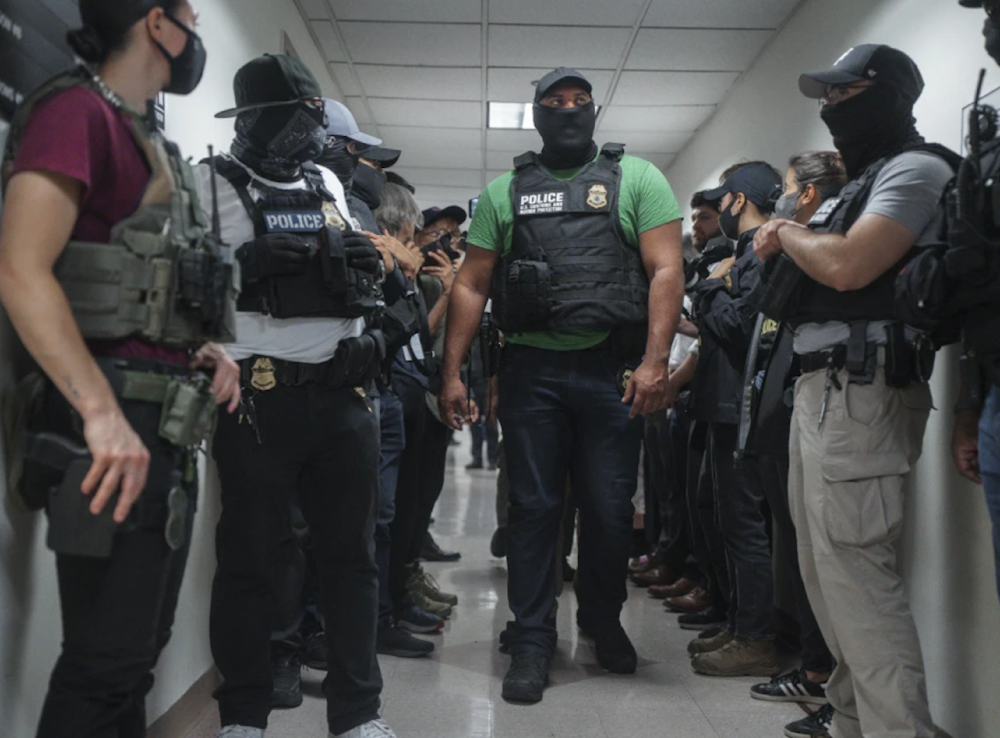ICE moves to shackle some 180,000 immigrants with GPS ankle monitors
A June 9 memo has instructed ICE field officers to dramatically increase the number of migrants under around-the-clock surveillance.
-

Masked federal agents wait outside an immigration courtroom, on July 8, 2025, in New York (AP)
According to an internal US Immigration and Customs Enforcement (ICE) document reviewed by The Washington Post, the agency has directed staff to expand the use of GPS-enabled ankle monitors as part of the Trump administration’s growing efforts to track individuals targeted for deportation.
The memo ordered ICE personnel to place ankle monitors on all individuals enrolled in the agency’s Alternatives to Detention (ATD) program “whenever possible".
Currently, about 183,000 adult migrants are enrolled in ATD and have agreed to some form of mandatory tracking or check-in while awaiting resolution of their immigration cases. Of those, only 24,000 currently wear ankle monitors.
20-year-old, controversial surveillance practice
Dawnisha M. Helland, acting assistant director for ICE’s Non-Detained Docket Management Division, stated in the memo that one exception would be pregnant women, who would instead be fitted with wrist-worn tracking devices. “If the alien is not being arrested at the time of reporting, escalate their supervision level to GPS ankle monitors whenever possible and increase reporting requirements,” Helland wrote.
The new ankle monitor directive marks a significant expansion of a 20-year-old, controversial surveillance practice. While ankle monitors are less expensive and potentially more humane than detention, migrants and advocates have long criticized the government’s use of the large black tracking devices, which they say are physically uncomfortable, socially stigmatizing, and invasive of privacy, especially for individuals with no criminal record or history of missing court dates.
Laura Rivera, senior attorney at Just Futures Law, a nonprofit that has researched ICE surveillance technology, said the tool would be used to "extend the reach of the government from just the folks it can manage to put in physical detention to an additional hundreds of thousands more that it can surveil."
“It’s designed to turn their own communities and homes into digital cages," Rivera expressed.
Flawed gang databases fuel ICE deportations without due process
Across the United States, state and local police are quietly sharing flawed gang database information with Immigration and Customs Enforcement (ICE), fueling a covert deportation system that targets immigrants without due process. An investigation by The Intercept reveals that at least eight states and major cities, including New York, Texas, Illinois, and Virginia, are contributing to these error-prone databases, which rely on subjective factors like clothing, tattoos, and associations, often without arrests or notification to those affected.
“This opens the door to an incredible amount of abuse,” said Nayna Gupta of the American Immigration Council. “This is our worst fear.”
ICE gains access to local intelligence through outdated systems like the FBI’s National Crime Information Center (NCIC), created in the 1960s, and post-9/11 fusion centers designed for terrorism intelligence. No court approval is needed. Instead, data move freely into ICE’s hands through systems like the “Gang File", developed with Palantir Technologies, co-founded by Trump ally Peter Thiel and still expanding under a $96 million Biden-era contract.
The human cost is staggering. In March, ICE deported Kilmar Abrego Garcia to El Salvador’s notorious mega-prison CECOT based on a flimsy police report citing nothing more than an informant’s word, a hoodie, and a Chicago Bulls hat, described as “indicative of Hispanic gang culture.” In February, ICE wrongly arrested Venezuelan barber Francisco Garcia Casique after confusing him with someone else. The database had the wrong photo.

 4 Min Read
4 Min Read










